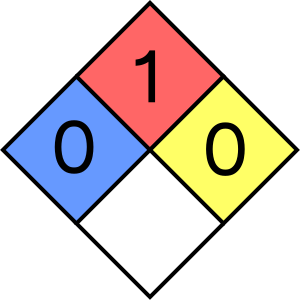AGAR (AGAR-AGAR)
Basic information
- Chemical formula(s): Complex polysaccharide (\({\rm (C_{12}H_{18}O_9)_n}\))
- Other names: Agar-agar, gelose, kanten, China grass
- CAS number: 9002-18-0
- EC number: 232-658-1
- Molecular weight: Variable (complex polysaccharide)
- International Chemical Safety Card (ICSC): N/A (see Roth Safety Data Sheet)
- Flammability: probably combustible (flash point data not available)
- Description: Beige to white powder derived from red algae cell walls. Odorless and tasteless. Food-grade gelling agent used in microbiology culture media.
NFPA 704 (fire diamond)

- Health (blue): 0 - poses no health hazard.
- Flammability (red): 1 - must be pre-heated before ignition can occur (probably combustible).
- Instability–reactivity (yellow): 0 - normally stable, even under fire exposure conditions, and is not reactive with water.
- Special notice (white): -
Hazard statements
Agar is not classified as hazardous under GHS regulations. Therefore, no H-codes are assigned.
| Code | Phrase |
|---|---|
| - | No hazard statements assigned (not classified as hazardous) |
Precautionary statements
Despite not being classified as hazardous, the following general precautionary measures apply for organic powder handling:
| Code | Phrase |
|---|---|
| P261 | avoid breathing dust/fume/gas/mist/vapours/spray |
| P264 | wash hands thoroughly after handling |
| P280 | wear protective gloves/protective clothing/eye protection/face protection |
Protective measures
Gloves
- Any standard laboratory gloves: very good - agar is non-toxic and non-irritating.
- Nitrile: very good - prevents contamination and provides good grip with powders.
- Natural latex or rubber: very good - adequate for food-grade material handling.
- Vinyl: very good - suitable for food-grade applications.
- PVC: good - adequate protection for non-hazardous powder.
Safety goggles
- Standard safety glasses recommended when handling large quantities to prevent dust irritation.
- Not required for small quantities but good laboratory practice.
- Corrective glasses are not considered safety goggles.
- Dust may cause mechanical irritation to eyes.
Clothing
- Standard laboratory clothing is sufficient.
- Long sleeves recommended when handling large quantities to minimize dust contact.
- Closed-toe shoes required as standard laboratory safety.
- No special protective clothing required for food-grade material.
Respiratory protection
- Dust mask recommended when handling large quantities or in poorly ventilated areas.
- Low hazard for usual industrial handling but minimize dust generation.
- Ensure adequate ventilation to prevent dust accumulation.
- Use full-face respirator if exposure limits are exceeded or irritation occurs.
Spill management
- Sweep up material carefully to minimize dust generation.
- Use vacuum with appropriate filtration if available.
- Avoid creating dust clouds during cleanup.
- Collect in appropriate container - can be disposed as non-hazardous waste.
- Clean area with damp cloth to remove residual dust.
- Biodegradable - environmentally safe material.
- No special disposal requirements - food-grade material.
Special warnings
- Generally recognized as safe (GRAS) - approved food ingredient and pharmaceutical excipient.
- Practically non-toxic - oral LD50 >15 g/kg (more than 1 quart for 70 kg person).
- Passes through intestinal tract mostly unabsorbed - minimal systemic toxicity.
- Dust irritation - may cause mechanical irritation to eyes and respiratory tract.
- Hygroscopic - absorbs moisture from air, store in dry conditions.
- Store in cool, dry place in tightly closed containers.
- Incompatible with strong oxidizing agents - standard organic material precaution.
- Fire extinguishing: Use dry chemical, carbon dioxide, or foam extinguisher.
- WHMIS classification: Not controlled (minimal regulatory requirements).
- Water hazard class 2 - slightly hazardous to water (WGK Germany rating).
- Derived from natural source - red algae (Rhodophyta) cell walls.